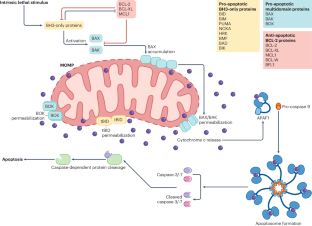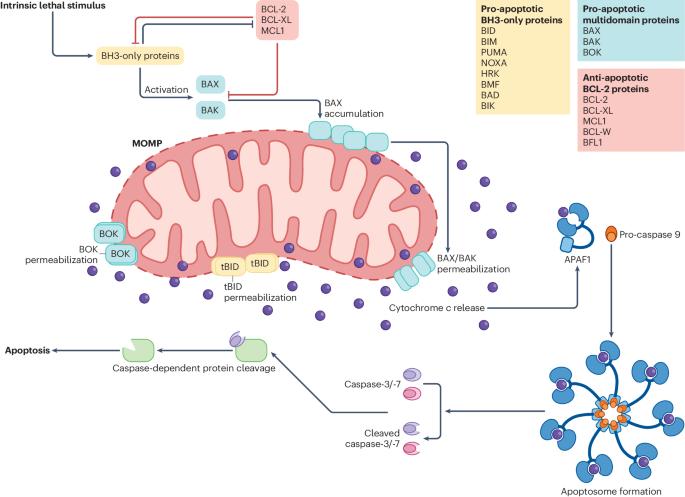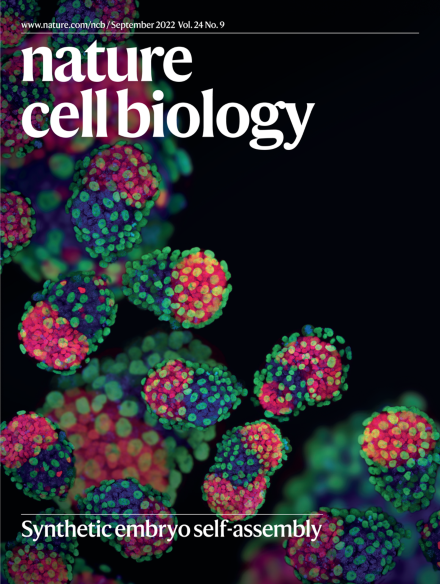线粒体与细胞死亡
IF 17.3
1区 生物学
Q1 CELL BIOLOGY
引用次数: 0
摘要
线粒体是细胞能量生产、钙平衡和铁代谢的工厂,但它们也通过释放细胞色素 c 在细胞内在凋亡中发挥着明确而核心的作用。虽然随后蛋白水解 Caspases 的激活确保了细胞死亡在没有附带炎症的情况下进行,但其他噬细胞死亡途径也牵涉到线粒体的使用或参与。在此,我们将讨论由 BCL-2 家族蛋白控制的内在凋亡的复杂性。我们强调了新出现的理论,即非致命性线粒体凋亡信号具有影响癌症、先天性免疫和衰老的多种生物学作用。最后,我们描述了线粒体在其他形式的细胞死亡(如热凋亡、铁凋亡和坏死)中的作用,并讨论了线粒体作为细胞死亡信号通路交叉和协调的中心枢纽的作用,强调了对线粒体进行治疗操作的潜力。本文章由计算机程序翻译,如有差异,请以英文原文为准。


Mitochondria and cell death
Mitochondria are cellular factories for energy production, calcium homeostasis and iron metabolism, but they also have an unequivocal and central role in intrinsic apoptosis through the release of cytochrome c. While the subsequent activation of proteolytic caspases ensures that cell death proceeds in the absence of collateral inflammation, other phlogistic cell death pathways have been implicated in using, or engaging, mitochondria. Here we discuss the emerging complexities of intrinsic apoptosis controlled by the BCL-2 family of proteins. We highlight the emerging theory that non-lethal mitochondrial apoptotic signalling has diverse biological roles that impact cancer, innate immunity and ageing. Finally, we delineate the role of mitochondria in other forms of cell death, such as pyroptosis, ferroptosis and necroptosis, and discuss mitochondria as central hubs for the intersection and coordination of cell death signalling pathways, underscoring their potential for therapeutic manipulation. Several processes of regulated cell death engage or use mitochondria, which are thus central hubs that not only coordinate cell death but also elicit non-lethal signalling mediated by mitochondrial outer membrane permeabilization.
求助全文
通过发布文献求助,成功后即可免费获取论文全文。
去求助
来源期刊

Nature Cell Biology
生物-细胞生物学
CiteScore
28.40
自引率
0.90%
发文量
219
审稿时长
3 months
期刊介绍:
Nature Cell Biology, a prestigious journal, upholds a commitment to publishing papers of the highest quality across all areas of cell biology, with a particular focus on elucidating mechanisms underlying fundamental cell biological processes. The journal's broad scope encompasses various areas of interest, including but not limited to:
-Autophagy
-Cancer biology
-Cell adhesion and migration
-Cell cycle and growth
-Cell death
-Chromatin and epigenetics
-Cytoskeletal dynamics
-Developmental biology
-DNA replication and repair
-Mechanisms of human disease
-Mechanobiology
-Membrane traffic and dynamics
-Metabolism
-Nuclear organization and dynamics
-Organelle biology
-Proteolysis and quality control
-RNA biology
-Signal transduction
-Stem cell biology
 求助内容:
求助内容: 应助结果提醒方式:
应助结果提醒方式:


